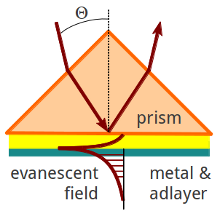Theory - Links
Confocal vs evanescent
Principles of evanescent illumination
Surface plasmons
Label-free detection
Surface plasmon fluorescence spectroscopy
Optical waveguide spectroscopy
Label-free detection
Using surface plasmon spectroscopy (SPS) as a label-free analytical tool
 If an additional adlayer of a dielectric compound is attached to the metal layer, the resonance frequency, i.e. the angle at which the surface plasmon is detected shifts to larger angles.
If an additional adlayer of a dielectric compound is attached to the metal layer, the resonance frequency, i.e. the angle at which the surface plasmon is detected shifts to larger angles.
In the so-called “scan mode”, again, angular scans are performed to obtain surface plasmon spectra, from which the optical thickness of the dielectric adlayer can be obtained by model-fit calculations.

Whereas the latter method yields static information about the generated adlayer at the metal surface, the surface plasmon resonance (SPR) technique can be also used to obtain kinetic information of the build-up of a dielectric adlayer at the surface in situ. In this case, the reflectivity is measured as a function of time at a distinct angle of incidence (left graph in figure below). Typically, the angle that is chosen, is at the lower flank of the decreasing reflectivity within the surface plasmon resonance peak (right graph in figure below). If now a dielectric compound binds to the interface, the resonance of the surface plasmon is shifted to higher angles due to the build-up of the dielectric layer. This shift causes the reflectivity at the flank of the resonance peak to increase over time until a constant value of the reflectivity is reached, i.e. no further build-up of the adlayer is achieved.
